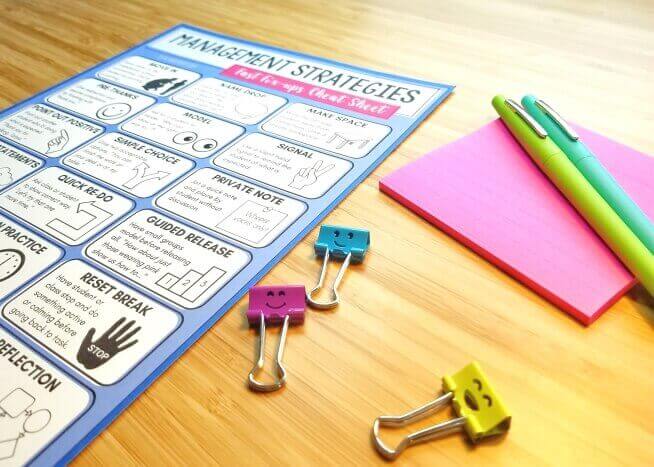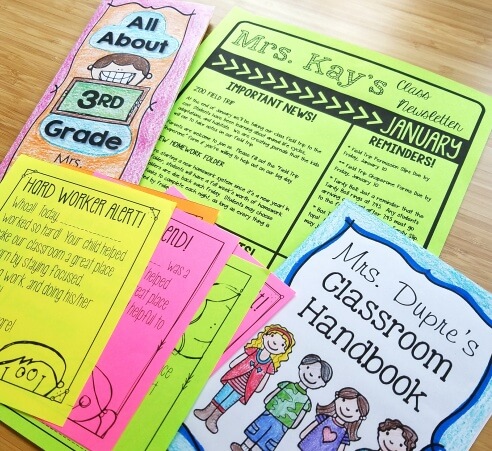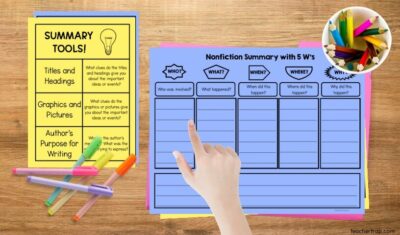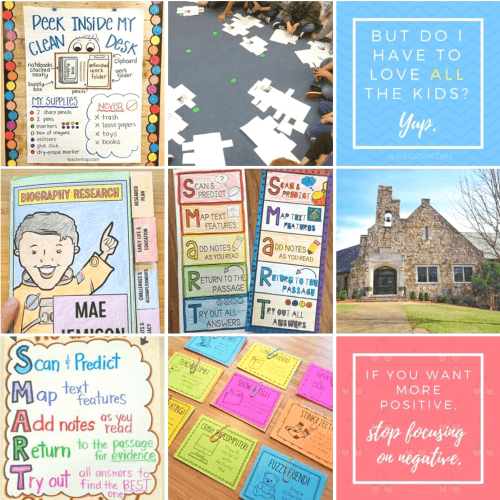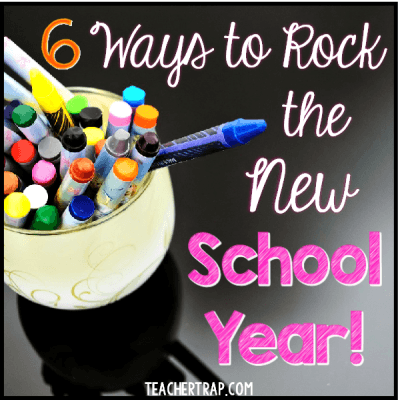
I love the thrill of “back to school” time! Getting ready for a new school year, meeting your new class for the first time, and those first few days of school are so exciting. But launching a new year is a “pay for it now or pay for it later” kind of time. This post is all about front-loading your semester so that you don’t end up spending half of it reteaching basic expectations, practicing procedures, or dealing with student bickering, tattling, or poor attitudes. Start the school year off right so you can enjoy the benefits later!
Here are 6 quick tips for a better “back to school!”
1. Build in LOTS of time for sharing.
Children need time to get to know their peers and their teachers. Even though we might want to jump into curriculum, we’ll pay the price later if we do!
Some kids need to share about themselves, some need to hear about others in the class, and some need to learn about YOU. It’s interesting to me how different children need different experiences to feel safe and comfortable.
For the first week of school, I recommend doing at least 2-3 sharing activities a day. Here are some ideas to get you going:
- Bring an item from home that means something special and tell the class about it
- Quick “Either/Or” Surveys (Stand if you prefer art class, wave if you prefer music class.)
- Share about a favorite person in your life
- Share a story about a favorite hobby, place, memory, etc.
- Quiz-Quiz Trade “Get to Know You” Questions
- Small lunch groups with the teacher
- Play “Two Truths and a Fib” (Class guesses which is the fib!)
- Create a poster of your favorite things to share and hang
The important part is that each student gets the chance to share who they are with both you and their classmates. And don’t forget to share about yourself, too!

2. TEACH expectations and PRACTICE procedures.
Creating a classroom that runs smoothly is more than hanging a poster of rules. But I know that many teachers, myself included, feel pressure to get going on curriculum and instruction and don’t give this part the real time and practice needed.
Take a minute to brainstorm and identify for yourself:
- What are your classroom behavior expectations?
- What procedures will students need to know and follow?
For both questions, make an exhaustive list! Include it all! Once I have my list, I start mapping out what needs to be taught and when. Some things need to be taught on the very first day, such as bathroom procedures, while others can wait until a few weeks into the year. I add the procedures and expectations I want to work on into my lesson plans just as I would any other lesson.
For procedures, create step-by-step anchor charts and PRACTICE the routines daily until students no longer need to refer to the chart.
3. Set GOALS and VISUALIZE.
Goal setting is probably one of the most common things to get skipped. The power of goal setting is that it helps students connect to their PURPOSE for being at school and to VISUALIZE what their time at school will look and sound like.
It’s important to help kids understand and set meaningful goals. For example, I have my students set “Math Goals” in the front of their Math Journals. Without direction, most students will set goals like “Do better in math” or “Make A’s in math.” For more focused goals, begin with a brainstorm of possibilities as a whole class. Have students consider what they struggled with last year and create a list of ideas together.
Potential Math Goals:
- Keep a positive attitude even when things get tricky.
- Practice my math facts at home.
- Show my work even when it takes more time.
- Keep an organized math journal.
Set goals as a class, too! Together, you can set goals for attendance, for positive attitudes, for homework, or for whatever gets the kids motivated.
Once the students have set goals, individually or as a class, make sure you give them time to visualize the outcome. What will it look like, sound like, and feel like to be on track with the goals? Students can write, draw, or even create comic strips that depict the process they will take to reach their goals.
4. Make TEAM-BUILDING a priority.
If you want your students to appreciate one another, work together collaboratively, and be supportive of each other, then you’ve got to help them feel like part of a TEAM. Team building activities are a great way for students to get to know each other, become sensitive to the strengths and needs of others, and to feel like they are a part of the group.
Here are a few simple ones that work well with elementary-aged students:
- Group Building Projects: Give groups of 4-5 students the same sets of materials. Assign a task, such as “build the strongest bridge” or “build the tallest tower” or “make a statue of the teacher,” and let them get to work!
- Keep the Balloon Up: Create groups of 3-5 students. Give each group a balloon and challenge the groups to keep their balloon in the air for 1 minute, then 2, then 3, etc.
- Puzzle Race: Create groups of 4-5 students and give each group a puzzle with the same number of pieces. (The Dollar Store has perfect ones!) Have groups race to put their puzzles together.
After team building activities, be sure to take time to debrief. Ask reflection questions like:
- What made this challenging?
- What is something someone said or did that was helpful?
- Did you want to give up? What helped you keep going?
- What did your team do that you really appreciated?
The discussion helps students become more aware of how groups can support each other and consider their individual role on a team.
5. CONNECT to last school year.
I’m always surprised by how much students forget over the summer. After all that hard work and learning, sometimes it feels like half of it just falls out of their heads over the break!
Rather than jumping into new learning, I make a point to have students remember and share things they learned last year. For example, as we begin Social Studies, I might have the kids create posters of words and drawings that represent everything they remember doing and learning in Social Studies last year. In Math, I might give them a “test” where all they have to do is mark each question green, yellow, or red (green = I definitely know how to do this, yellow = looks familiar, red = don’t remember this at all) In Reading, our first anchor chart is students brainstorming ideas about “what good readers do.”
These types of connecting activities have a way of jump-starting their little brains and bringing past learning to the surface. And, as I begin to recognize gaps in learning, I can immediately begin reviewing and reteaching things that I know students will need in upcoming lessons.
6. Save the day with READ-ALOUDS.
In my personal opinion, the read-aloud is the most powerful and magical thing that happens in classrooms. Class getting rowdy? Read aloud. Students bickering? Read aloud. Want to get kids excited about a topic? Read aloud.
During the first week of school, I might do 2 – 3 read-alouds a day. They are great for sparking conversations about nervousness, making friends, behavior, school expectations, and any other topic you want to focus on that first week back. I also find that they are a great way to calm anxious minds and get kids back into a “listening and thinking mode.”
Here are some of my favorite “back to school” read-alouds (affiliate links):
To recap:
SLOW DOWN! I was once told, “Sometimes you have to go slow to go fast.” This is a great example of just that. By taking the time to do things right in the beginning, you save yourself the frustration and wasted time later. Set your class up for SUCCESS!
If you’re looking for more back-to-school resources, check out my Back to School Mega Bundle! You’ll find all my most popular activities and printables for launching an awesome new school year including the Editable Classroom Handbook, Newsletter, and Brochure, AND the Positive Parent Communication Pack!







